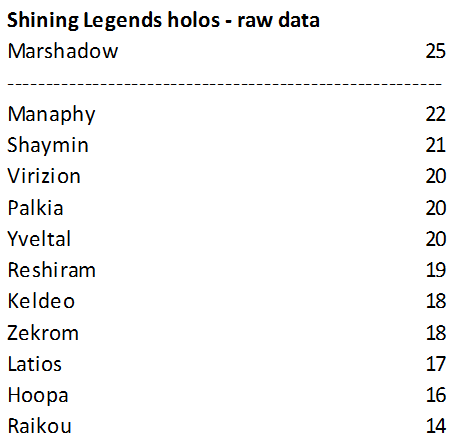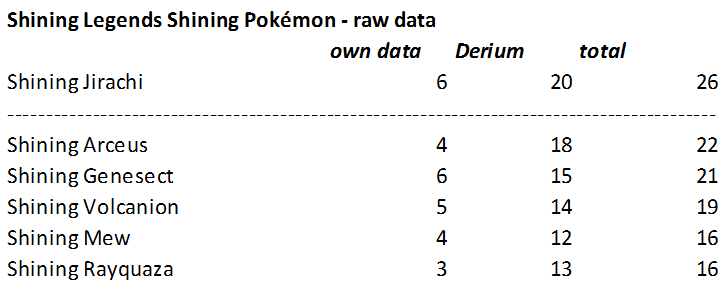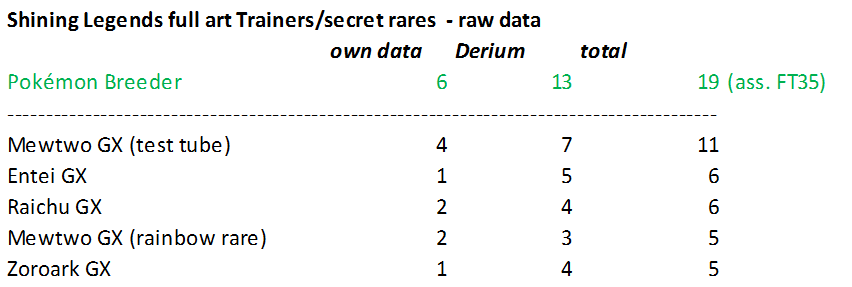Shining Legends
I made a mistake when summarizing the data for this set, thinking at first the reverse/holo Basic Energy cards were printed separately from the other reverses, and even went back to my post on Generations and edited it assuming it would be the same case there. Then I realized however that the pattern printed on the non-energy reverses is deceptive and the actual holofoil pattern is the same for them and the Basic Energy cards. So I undid my edit on Generations.
To be sure about my theory that all reverses were printed on the same sheet is plausible, I speed-watched two Youtube videos by Derium counting how many reverse energies he got. They were large openings, one of 501 packs, the other of “501 or 502”. Assuming each reverse Basic Energy is printed once on the sheet, the expected number is 9 / 121 * 501 = 37.26. In the two openings I counted 29 and 37, respectively. The first number is suspiciously low, but I am assuming it is not statistically relevant. The fact that the packs come from various sources of product and not from booster boxes, when you usually get 36 reverses in sequence from the sheet, ought to lead to higher uncertainty. (It is also possible I missed one or two when speed watching the videos.) Anyway, I will be assuming only one sheet was used for all the reverses.
The set features holos, “regular” Pokémon-GX, full art Pokémon-GX, one full art Trainer, secret rares and 6 Shining Pokémon, but no non-holo rares; all of these cards come in the rare slot. Going by holofoil pattern, I will assume the sole full art Trainer (Pokémon Breeder) and all secret rares were printed on one sheet. This includes the “Test Tube Mewtwo”, aka “MewTube” secret rare, which while having the layout of a regular Pokémon-GX is textured like the other secret rares.
For the pull rates, I have three of the four sources I used for the main sets back in my introductory post on the Sun & Moon Series, namely my own data from Youtube videos (1), that posted on E4 by @burpies (Pull Rates in Sun & Moon - Sword & Shield Sets) (2) and the two videos by Derium (4). It is possible (2) includes the data from (4). Here are the “box ratios” for the various types of cards (I am calculating box ratios for the sake of comparison with other sets even though Shining Legends was not sold in booster boxes):
My own sample is the smallest of the three by far; it is also an outlier. In my model I am going to go with 4.0 “regular” Pokémon-GX, 1.0 full art Pokémon, 1.4 full art Trainers/secret rares and 3.2 Shining Pokémon per “box”. The first three are also consistent with other Sun & Moon series sets, while the ratio for the Shining Pokémon is based solely on the data above.
The rarity table looks as follows (the box ratios nbox are grayed out as there are no booster boxes):
As can be seen, the model leads to the full art Pokémon-GX having exactly half the pull rates as the “regular” ones, which is kind of neat. For the full art Trainer/secret rare sheet, the three sources of data suggests secret rares take up around 62.5 to 67.3 slots on the 10x10 sheet. I am thus assuming Pokémon Breeder to be printed on the sheet 35 times, and the five secret rares 13 times each.
The raw data for the holos, full art Trainer/secret rares and Shining Pokémon is as follows (the “regular” and full art Pokémon-GX are assumed to all have the same pull rate):

It is certainly interesting that “MewTube” appeared more often than the other secret rares, but I don’t think the sample size is large enough to conclude that this is meaningful, so I am modelling all secret rares with equal pull rates.
Edit 2024/03/24: Changed sequence length from 180 to 360. This has no impact on pull rates.



